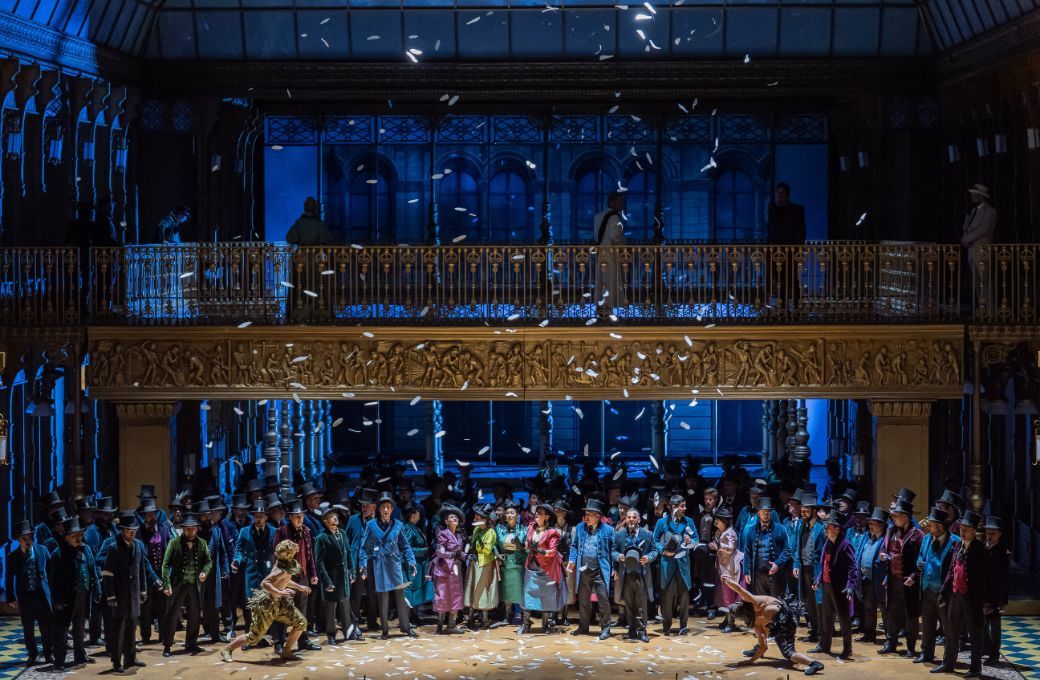The Hungarian State Opera last staged Lohengrin in 2004, in a still-infamous production by Katharina Wagner which shifted the opera’s setting to the 1989 revolutions and turned Lohengrin into a populist leader, in a soberly pessimistic and greatly prescient evaluation of Central European regime changes.

In replacing Wagner’s socreal bureaus and grey-suited apparatchiks, András Almási-Tóth’s so-called “steampunk” Lohengrin seems anxious not to offend, sticking to straightforward storytelling and only moving the setting to the mid-19th century. Sebastian Hannak’s sets situate the opera in a gold-plated courtyard, though the (presumed) ducal palace’s tacky splendor could pass for a shopping arcade. The Telramunds’ and Elsa’s bedrooms, a striking combination of monochromatic black and gold, make an appearance in Acts 2 and 3 in a vertically split box. Krisztina Lisztopád’s generically Victorian costuming is somewhat garish for the principals, but well tailored and agreeably colorful for the chorus, with velvet frock coats and dresses (though the above-ankle dresses strike me as a century too early here).
Unfortunately, if Almási-Tóth's concept was to expose a profound emptiness beneath this prosperous society’s glamour, his staging proves to be much the same: flashy, with little substance. Beyond cursory gestures communicating a sexist attitude, we learn little of this world’s ways, values or relevance. Lohengrin, who arrives bedecked in tinfoil armor, seems appropriately alien, yet he feels simply blank and grey as his garb, without much of a supernatural aura. An actually steampunk setting could have leant him a fantastical bent, but the staging isn’t even aesthetically interested in pursuing its supposed genre of choice. Instead, it opts for the superfluous inclusion of a black and golden pair of feuding swans: abducted and enchanted, Gottfried will appear as a mix of the two. The black swan’s alliance is self-explanatory, but the golden one is confounding: visually aligned with Elsa and a symbol of Brabantine society, it also stands for the outsider Lohengrin in the duel. The swans’ struggle, offering mostly unnecessary, distracting stage business, ultimately ends in Ortrud’s triumph: Gottfried returns restored but corrupted, capping the finale with a coup d'état.
Beyond this superficiality, a more frustrating aspect is the sheer technical clumsiness, both from Almási-Tóth and Hannak. The raised passageway in Act 1 that the king and most principals sing from is acoustically catastrophic and displays a characteristic problem with the stage space's inconsistent treatment: the chorus, standing on the ground floor, turns away from the audience as the king addresses them, but turns back again when they have to sing – with their backs to the person they are meant to be replying to. This proves a recurring issue, as does the chorus' direction in general: with awkward blocking, the stage is so cramped in the Act 2 finale that at “Zurück, Elsa”, Elsa and Ortrud are effectively immobile, rendering a dramatic high point a complete dud. In the finale, the female chorus sings from the parterre aisles because they simply have no space onstage, blocked out by the "bedroom" box. These are confounding misfires from seasoned professionals – and other than a few inspired moments of personenregie, the staging offers little in way of concept or execution to compensate for them.
Musically, the performance (the only one for the Hungarian cast) was somewhat dampened in vigor, as the house forces had to follow last evening’s premiere with an 11am matinee. Conductor Martin Rajna took a leisurely stroll through Act 1, conjuring more of a pleasant shimmer than ethereal beauty. The following acts were thankfully more tightly woven, energetic and dramatically impactful, with colorful playing from the orchestra, from the exquisite menace of the cellos in the Act 2 prelude to the lustily bombastic brass of the Wedding March, and reliable work from the chorus.
Debuting in the title role, Szabolcs Brickner got through the opera largely unscathed but achieved little more: his bright tenor’s tight sound doesn’t lend itself to lyricism, and his tone has a lachrymose quality that feels ill-suited to the Grail knight. (To his credit, his chemistry with Klára Kolonits's Elsa was genuine and touching.) Kolonits, in a role debut of her own, was a radiant standout, her crystalline soprano lending impassioned purity and force of conviction to her Elsa, the most vividly portrayed figure of the staging. Szilvia Rálik's penetrating tone and forceful gale of a voice made for an appropriately devious, dominant Ortrud, convincing in spite of a loose vibrato and tendency for cartoonish overacting. Sparks flew in her Act 2 duet with Károly Szemerédy's dark, vehement Telramund, a clear musical highlight of the performance. András Palerdi's dry-toned, gravelly Heinrich didn't cut a vocally regal figure.


